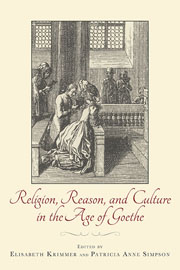Book contents
- Frontmatter
- Contents
- Acknowledgments
- Introduction
- I Wieland and Herder
- II Schiller and Goethe
- III Kleist and Hölderlin
- 6 Saint Mary's Two Bodies: Religion and Enlightenment in Kleist
- 7 Catholic Conversion and the End of Enlightenment in Religious and Literary Discourses
- 8 Sacred Maternity and Secular Sons: Hölderlin's Madonna as Muse
- IV Leibniz, Spinoza, and Their Legacy
- Notes on the Contributors
- Index
6 - Saint Mary's Two Bodies: Religion and Enlightenment in Kleist
from III - Kleist and Hölderlin
Published online by Cambridge University Press: 05 December 2013
- Frontmatter
- Contents
- Acknowledgments
- Introduction
- I Wieland and Herder
- II Schiller and Goethe
- III Kleist and Hölderlin
- 6 Saint Mary's Two Bodies: Religion and Enlightenment in Kleist
- 7 Catholic Conversion and the End of Enlightenment in Religious and Literary Discourses
- 8 Sacred Maternity and Secular Sons: Hölderlin's Madonna as Muse
- IV Leibniz, Spinoza, and Their Legacy
- Notes on the Contributors
- Index
Summary
Enlightenment Rationalism and Catholicism
The influence of religious traditions on German thought of the Classical period cannot be appreciated enough. Beginning in the early Enlightenment and spanning literary movements from Sentimentality and Storm and Stress through Weimar Classicism and Romanticism, German literature grappled with this powerful, largely Lutheran and Pietist legacy, which it transposed into its own secular worldview. Literary fiction, aesthetic experience itself, had become the central medium of secularization. This is also reflected in the biographies of many writers of the time; we are reminded of the notoriously high number of pastor's sons—most prominently perhaps Lessing—many of whom broke away from the intended clerical path, and of the many more who were shaped by a Pietist upbringing, from Klopstock and Herder to Karl Philipp Moritz, Novalis, and the early Romantics.
Little is known about Kleist's biography, even less about his religious upbringing and outlook. His familial background in Prussia's military aristocracy—quite unusual for intellectuals of his time—as well as the social milieu of his hometown Frankfurt an der Oder and later the Potsdam Cadet School were Protestant, of course, with some Pietist influences. The letters he wrote his fiancée serve as the main source for determining Kleist's intellectual and spiritual development after leaving the army in 1799.
- Type
- Chapter
- Information
- Religion, Reason, and Culture in the Age of Goethe , pp. 141 - 165Publisher: Boydell & BrewerPrint publication year: 2013

